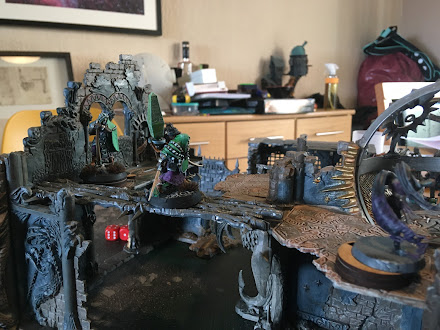What is Games Workshops best game?
The correct answer was always Space Hulk. It's a lean focused design that nails the aliens corridor shooter experience. Some of the narrative games came close, Necromunda and Mordheim, Battlefleet Gothic had the best box cover, but really it was always Space Hulk.
Well that's what I thought until yesterday. Warcry is the best game GW have ever made. Hands down.
 |
| The Spiranx looks on with its Chaos Turkey companion! |
I'm really drawn to games that know what they are trying to be and set out manchette in hand into the jungle to hack out that goal. Warcry is basically Warhammer goes to the Thunder Dome. A standard game has 3 turns, is objective based, and uses one die roll to resolve most actions. Its very quick and razor sharp. You deal with the chaos, construct a plan and whip out half of each others warbands in 30-60 minutes.
 |
| Pick axes to the face of the dark elf scum |
The core engine is a fairly stripped down standard GW fair. It's I go, you go, but moving one miniature rather than your whole warband of ~10 figures. The figure gets 2 actions, it can move, it can attack, and that's about it. The stat lines for each figure are printed on cards that come in the box so set up and warband building is very fast. There's not a lot to the stats; move, toughness (defence), attack and some markings that allow you to trigger some special abilities. More on those in a second.
 |
| Defending my quarter and failing |
The game has two mechanisms that move it from quick and competent to excellent.
1. at the start of the turn, each player rolls 6 dice, any doubles, triples or quads you roll can be spent on faction specific special abilities when you activate a figure. Typically these are going to pump up your attacks, give extra moves etc. Sometimes they combo with precise figure placement, for example my Obelisk worshipping cultists can heal if they are within a certain range of the floating obelisk carrier.
This light resource management system forces you to plan your turns, sequence actions and make smart gambles. It also brings a lot of the unique flavour to each faction that GW really excels at and keeps the design space open for future warbands.
 |
| You shall not pass |
2. At the start of each scenario you randomly roll or draw (depending on whether you own the card deck or use the tables in the back of the expansion books) the deployment, the scenario, a twist and potentially the terrain. A point of frustration here. The card decks / deployment tables are fairly essential and hard to acquire outside of the big box sets. The core rules do contain two example setups.
The deployment cards are great. The play area is 3 by 2ft, your warband is divided into 3 preassigned groups and then deployed at various points. Some may be right in the middle next to your opponent, some at opposite corners and some at the edges. Couple this with a randomly drawn objective, which are typically capture and hold variants, area denial, or kill X, and you have a scenario that forces both players to think on your feet. With three turns you have to be hyper focused on the goal and get straight into your opponent. It's difficult to express how this input randomness generates such depth. Every scenario is unique and interesting and the all feel surprisingly tight.
 |
| On the Catacombs expansion board - fun but non essential variant |
The twist card is an extra hook thrown into the scenario. It can be simple like the floor is swamp and all non flying figures move at -1, it can be a beast in the darkness that eats a random figure every turn, or an additional dice that everyone gets in their pool at the start of the turn. Putting this set up and the terrain all together and there is a huge variety of surprisingly balanced scenarios. Yeah some factions will be at a disadvantage in some setups, but the games are so quick you can play 2-4 in an afternoon. The shifting balance helps the game experience, you cannot really over optimise your warband or game the system to heavily, and sometimes the weaker player will win. For me this is golden, I want to feel rewarded when I play well, but I don't want to be shut out if I have not internalised every faction and rule in the book.
A quick comment on terrain. GW is selling a lot of plastic terrain bits for this game. They are not cheap (but not super expensive compared with other GW stuff). This game works fine with a good amount of any old scatter terrain. You do want probably 3-5 bits of elevated terrain as some scenarios require the objectives to be raised off the floor. These bits could just be tactical rocks. I'd recommend half a dozen bits of wall and perhaps 3-4 pillars or bits of rubble etc. Obviously theming the terrain will help with aesthetics and some items of GW terrain have special rules. But you can always create your own terrain rules or find others ideas online. Personally I like some of the GW terrain pieces but some look like they fell out a He-Man toy box in the 1980s.
If you like GW games, or just quick skirmish games, I highly recommend Warcy.
Bonus note; https://warcry.zuckerrausch.de/ use this website if you do not own the card sets for deployment and terrain etc.
Good review there mate. You make some bold claims, the stripped down sound of the rules does appeal though. Would love to give it a try sometime though.
ReplyDeleteCheers,
Pete.